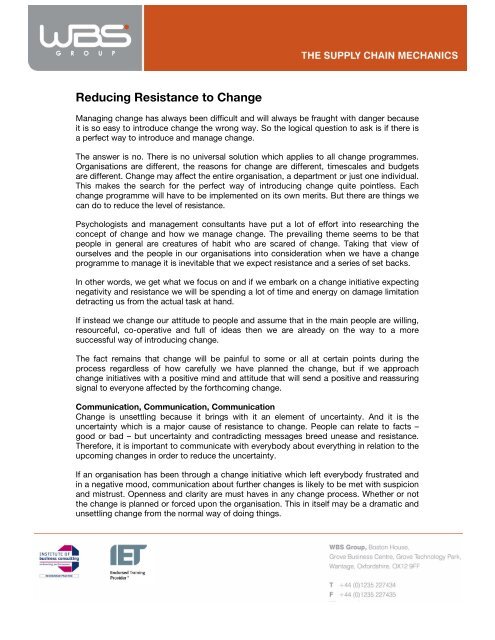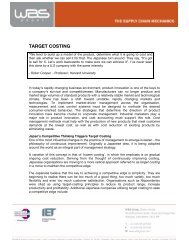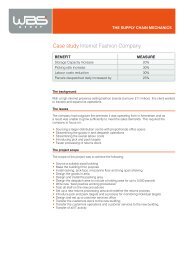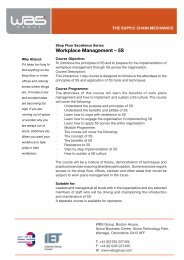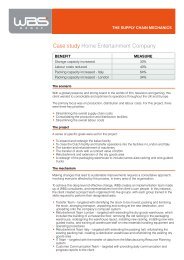Reducing Resistance to Change Resistance to Change - WBS Group
Reducing Resistance to Change Resistance to Change - WBS Group
Reducing Resistance to Change Resistance to Change - WBS Group
Create successful ePaper yourself
Turn your PDF publications into a flip-book with our unique Google optimized e-Paper software.
<strong>Reducing</strong> <strong>Resistance</strong> <strong>to</strong> <strong>Change</strong><br />
Managing change has always been difficult and will always be fraught with danger because<br />
it is so easy <strong>to</strong> introduce change the wrong way. So the logical question <strong>to</strong> ask is if there is<br />
a perfect way <strong>to</strong> introduce and manage change.<br />
The answer is no. There is no universal solution which applies <strong>to</strong> all change programmes.<br />
Organisations are different, the reasons for change are different, timescales and budgets<br />
are different. <strong>Change</strong> may affect the entire organisation, a department or just one individual.<br />
This makes the search for the perfect way of introducing change quite pointless. Each<br />
change programme will have <strong>to</strong> be implemented on its own merits. But there are things we<br />
can do <strong>to</strong> reduce the level of resistance.<br />
Psychologists and management consultants have put a lot of effort in<strong>to</strong> researching the<br />
concept of change and how we manage change. The prevailing theme seems <strong>to</strong> be that<br />
people in general are creatures of habit who are scared of change. Taking that view of<br />
ourselves and the people in our organisations in<strong>to</strong> consideration when we have a change<br />
programme <strong>to</strong> manage it is inevitable that we expect resistance and a series of set backs.<br />
In other words, we get what we focus on and if we embark on a change initiative expecting<br />
negativity and resistance we will be spending a lot of time and energy on damage limitation<br />
detracting ting us from the actual task at hand.<br />
If instead we change our attitude <strong>to</strong> people and assume that in the main people are willing,<br />
resourceful, co-operative and full of ideas then we are already on the way <strong>to</strong> a more<br />
successful way of introducing change.<br />
The fact remains that change will be painful <strong>to</strong> some or all at certain points during the<br />
process regardless of how carefully we have planned the change, but if we approach<br />
change initiatives with a positive mind and attitude that will send a positive and reassuring<br />
signal <strong>to</strong> everyone affected by the forthcoming change.<br />
Communication, Communication, Communication<br />
<strong>Change</strong> is unsettling because it brings with it an element of uncertainty. And it is the<br />
uncertainty which is a major cause of resistance <strong>to</strong> change. People can relate <strong>to</strong> facts –<br />
good or bad – but uncertainty and contradicting messages breed unease and resistance.<br />
Therefore, it is important <strong>to</strong> communicate with everybody about everything in relation <strong>to</strong> the<br />
upcoming changes in order <strong>to</strong> reduce the uncertainty.<br />
If an organisation has been through a change initiative which left everybody frustrated and<br />
in a negative mood, communication about further changes is likely <strong>to</strong> be met with suspicion<br />
and mistrust. Openness and clarity are must haves in any change process. Whether or not<br />
the change is planned or forced upon the organisation. This in itself may be a dramatic and<br />
unsettling change from the normal way of doing things.
But what does communication mean It means informing everyone at every stage of the<br />
change programme. It means inviting feedback on information and responding promptly<br />
and honestly <strong>to</strong> any feedback received. Communication is a dialogue between those<br />
managing change and those affected by it.<br />
Communication must happen at all levels of the organisation and, if necessary, the outside<br />
world must be kept in the loop as change may affect suppliers or cus<strong>to</strong>mers. And do not be<br />
afraid <strong>to</strong> involve the unions right from the start. Be positive and treat unions as your friends.<br />
You will need their support at some stage.<br />
Use any communication channels available and remember that it is impossible <strong>to</strong> over-<br />
communicate change. Some people may get fed up with the message, sage, but even more<br />
people including those who would normally support change will get frustrated if there is no<br />
communication or just evasive communication.<br />
Involvement, Involvement, Involvement<br />
If people are involved in change and understand the reasons for it they become supportive<br />
of the whole idea and the change process. If people are given the opportunity <strong>to</strong> take<br />
responsibility and accountability for certain parts of a change programme their sense of<br />
ownership will make them even stronger advocates.<br />
Teams can be set up <strong>to</strong> problem solve, brain s<strong>to</strong>rm or implement individual change projects<br />
contributing <strong>to</strong> the overall change programme.<br />
Once the volunteers have put their hand up, the next task is <strong>to</strong> encourage others <strong>to</strong> take<br />
part as well. Doing this by force of management is unlikely <strong>to</strong> yield good results. Instead a<br />
careful process of matching strengths and talents with specific tasks could be quite<br />
motivational.<br />
Always involve representatives from the areas affected. Turning up for work <strong>to</strong> notice that<br />
your desk or work bench has been moved will cause no end of resentment.<br />
People do not mind change, they just hate being changed.<br />
The 5D Approach <strong>to</strong> <strong>Change</strong> Management<br />
A change programme needs <strong>to</strong> follow a logical process in order <strong>to</strong> be effective. Without<br />
structure it does not matter what and how much you communicate and it does not matter<br />
whether people are involved or not. Without a structure and without a plan any change<br />
programme will fail.<br />
A simple, yet effective framework for change management is the 5D approach which sets<br />
out 5 logical steps <strong>to</strong> follow. Do each of them well and there is a good chance your change<br />
programme will succeed with a minimum of resistance. Remember <strong>to</strong> communicate and<br />
involve people at every state!
Step 1 – Definition<br />
Before doing anything it is important <strong>to</strong> understand exactly the reasons for and implications<br />
of change. What brought it about Who wants it How fast must we act<br />
Who will be<br />
affected<br />
Step 2 – Discovery<br />
Do not change anything until you have assessed what you have currently got. Changing<br />
something that already works and which does not need <strong>to</strong> change will cause resistance. So<br />
examine the current state and identify what is good about it. By keeping the best you can<br />
retain the life and soul of a department or organisation despite changes.<br />
Step 3 – Dream<br />
What would the ideal future look like Imagine what the ideal future would look like<br />
regardless of whether you are changing the layout of a shop floor, introducing a new<br />
service or product or relocating the whole company. Remember <strong>to</strong> sanity check so that you<br />
end up with the ideal solution within any given constraints<br />
Step 4 – Design<br />
Knowing the end result, it is now time <strong>to</strong> find a way of getting <strong>to</strong> this result. The Design step<br />
will involve the development of different options and the implementation of the chosen<br />
option will need <strong>to</strong> be planned. This will lead <strong>to</strong> a project plan for the solution which comes<br />
closest <strong>to</strong> the ideal future. Very rarely do you have unlimited resources <strong>to</strong> get what you<br />
want.<br />
Step 5 – Destiny<br />
It is important not <strong>to</strong> forget how <strong>to</strong> deal with the change once it has been implemented. The<br />
new situation needs <strong>to</strong> be sustained and become the current state. The Destiny step is all<br />
about finding ways of adjusting, learning and empowering people <strong>to</strong> work with the newly<br />
introduced changes whatever they may be. Never let a change programme s<strong>to</strong>p at the last<br />
item of the implementation plan. <strong>Resistance</strong> will occur if people feel left <strong>to</strong> their own<br />
devices in a new and unknown situation. This could destroy any successes s you may have<br />
had along the way <strong>to</strong> step 5.
Fig 1. The 5D Approach<br />
Adapted from Lewis et al 2007<br />
The 5D approach is a framework and needs <strong>to</strong> be applied on a “horses for courses” basis.<br />
The approach is essentially the same whether it is an employee appraisal or the relocation<br />
of a fac<strong>to</strong>ry. The trick is <strong>to</strong> apply the right mix of structure, rigour and flexibility.<br />
<strong>Resistance</strong> may come in different guises ranging from the slamming of doors, shouting and<br />
crying <strong>to</strong> deliberate non-cooperation and passive aggression <strong>to</strong> the surprise letter of<br />
resignation.<br />
Keeping everybody informed and involved as well as keeping a finger on the pulse will go a<br />
long way <strong>to</strong>wards a low resistance change programme.


